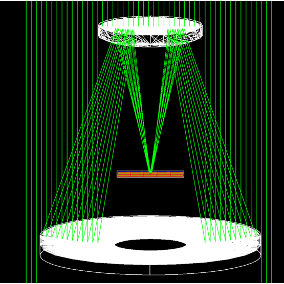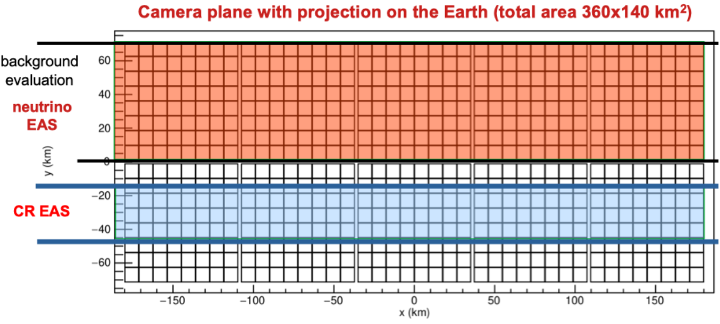NUSES and Terzina telescope

The NUSES (Neutrinos and Seismic Electromagnetic Signals) satellite mission is an upcoming project aimed at exploring new scientific and technological pathways for future astroparticle physics space-based detectors. The mission is scheduled to be launched in 2026 and will operate at a Low Earth Orbit (LEO) with an altitude at the Beginning of Life (BoL) of 535 km, along with a high inclination of 97.8° (LTAN = 18:00) in a heliosynchronous orbit along the day-night boundary. The NUSES mission is expected to last for three years.
The satellite will host two innovative scientific payloads: Zirè and Terzina. Ziré is a scintillation and silicon photo-sensing matrix that aims to study Gamma-Ray Bursts (GRBs) and detect cosmic rays (CRs) in the energy range of a few to hundreds of MeVs. Terzina, on the other hand, is a new optical telescope concept designed to detect Cherenkov light in space and neutrinos. It serves as a pathfinder to future space missions like POEMMA, combining atmospheric Cherenkov light observation and the use of Silicon Photomultipliers (SiPMs) for the detection of high-energy CRs and neutrinos.
It is worth mentioning the technology developments targeted by NUSES as this microsatellite will be a pathfinder and a precursor of a fleet of flying elements. The Thales company in Italy (TAS-I) will prove the concept of the New Italian Micro BUS (NIMBUS), which is a new ballistic platform concept for LEO microsatellites. This foresees a modular approach relying on standard trays. Additionally, at UNIGE, we are cooperating with the Fondazione Bruno Kessler on the development of robust photosensors for space applications. These are based on the NUV-MT, which uses metal trenches to reduce cross-talk between sensor microcells to a few per cent levels of accuracy. The robustness will also depend on the radiation hardness of silicon. It has been exposed to proton beams and electrons from strontium 90Sr decay.
Terzina telescope is specifically designed to detect Cherenkov light emitted by extensive air showers (EAS) induced by ultra-high-energy cosmic rays (UHECRs) and neutrinos in the Earth's atmosphere. Additionally, Terzina will monitor the light emissions from the Earth limb in the near-UV and visible ranges at the nanosecond timescale, which will help test the observational concept of detecting Earth skimming astrophysical high-energy neutrinos. At extremely high energies, tau neutrinos and muon neutrinos passing through the Earth can produce tau and muon leptons, which can emerge by decaying or interacting in the atmosphere. These interactions result in Earth skimming events, which create EAS moving in the atmosphere from bottom to top, similar to the EAS produced by charged particles impinging the atmosphere from above the Earth's limb. The Cherenkov emission from these EAS can be detected by space-based instruments with high exposures.
 The telescope will be inclined at an angle of 67.5 degrees with respect to the nadir, with the optical axis pointing towards the dark side of the Earth's limb. The expected duty cycle of the telescope is around 40%.
The telescope will be inclined at an angle of 67.5 degrees with respect to the nadir, with the optical axis pointing towards the dark side of the Earth's limb. The expected duty cycle of the telescope is around 40%.
The Terzina detector is made up of a near-UV-optical telescope with Schmidt-Cassegrain optics and a Focal Plane Assembly (FPA). The optical system uses a dual-mirror configuration consisting of a primary mirror, which is placed about 40 mm away from the FPA and has a radius of about 394 mm, and a secondary mirror with a radius of about 144 mm. The two mirrors are positioned about 280 mm apart.
Thanks to the Schmidt-Cassegrain optics, the upper row of 5 SiPM arrays is dedicated to observing events coming from below the Earth's limb. It will provide a clear characterization of the background and is unlikely to observe neutrino-induced EAS. On the other hand, the lower row of 5 SiPM arrays will observe events coming from EAS (Extensive Air Showers) generated by Cosmic Rays above the limb.
 |
 |
The FPA is designed to detect photons from both below and above the Earth's limb. It has a rectangular shape with a 2:5 aspect ratio and is composed of 10 SiPM (Silicon Photomultiplier) arrays. Each array contains 8 x 8 pixels of 3 x 3 mm each, arranged in 2 rows of 5 arrays each, for a total of 640 pixels overall.
 A simulation pipeline has been constructed to evaluate the performance of the telescope. Using the Extensive Air Shower Cherenkov Simulation (EASCherSim) computational framework, the Cherenkov emission observed from a space-based telescope during an above-the-limb EAS has been estimated. The Cherenkov emission can be observed from a small layer of the atmosphere with an angular size of less than 1°, at an altitude above the limb ranging from 20 km up to 50 km, given the observation geometry from the Terzina altitude and atmospheric characteristics. Implementing the design in the Geant4 toolkit, a dedicated Monte Carlo simulation of photon propagation to the telescope has been created.
A simulation pipeline has been constructed to evaluate the performance of the telescope. Using the Extensive Air Shower Cherenkov Simulation (EASCherSim) computational framework, the Cherenkov emission observed from a space-based telescope during an above-the-limb EAS has been estimated. The Cherenkov emission can be observed from a small layer of the atmosphere with an angular size of less than 1°, at an altitude above the limb ranging from 20 km up to 50 km, given the observation geometry from the Terzina altitude and atmospheric characteristics. Implementing the design in the Geant4 toolkit, a dedicated Monte Carlo simulation of photon propagation to the telescope has been created.
The background is expected to consist of electrons (trapped) and protons (trapped and solar). It will also include the Night Glow Background and city lights, as well as atmospheric factors such as auroras, lightning, and clouds. We anticipate that electrons and protons will be the primary sources of background. However, ionizing radiation from protons and heavier nuclei can cause damage to the silicon of SiPMs. Additionally, neutrons can induce dislocations within the crystal structure, which can increase the Dark Count Rate (DCR). The extent of the damage depends on the cosmic ray radiation spectra obtained with SPENVIS for Terzina’s orbit. To estimate the radiation dose accumulated by the SiPMs based on the electron and proton spectra, we utilize the full simulation of the telescope.
In conclusion, the Terzina telescope is an innovative optical telescope designed to detect high-energy neutrinos and cosmic rays. The mission holds the promise of advancing our understanding of astrophysical phenomena and paving the way for future breakthroughs in space-based astroparticle physics research.
